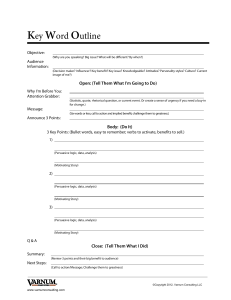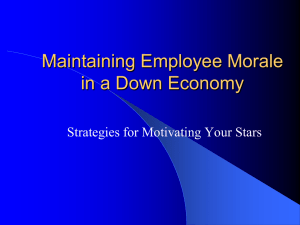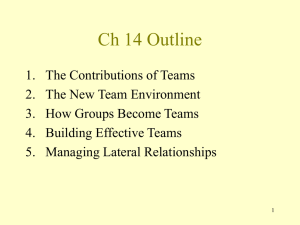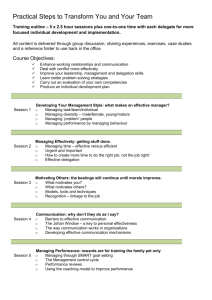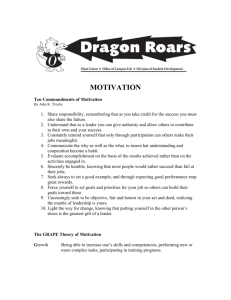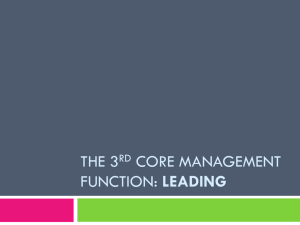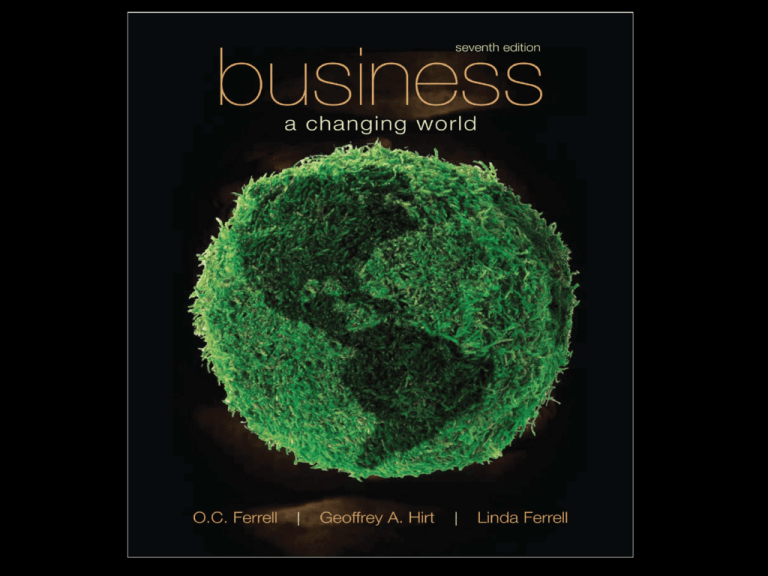
10-1
Business in a
Changing World
Chapter 10
Motivating the Work Force
2
McGraw-Hill/Irwin
Copyright © 2009 by the McGraw-Hill Companies, Inc. All rights reserved.
10-3
Amadeus Consulting: Where
Employees are the Company
Lisa Calkins and John Basso have created a
company for which people are motivated to
work for the long term.
10-4
Motivating the Workforce
Nature of Human Relations
What motivates employees to perform?
How can managers boost morale?
How do you maximize worker performance?
How can you encourage creativity and innovation?
10-5
Motivating the Workforce
Nature of Human Relations
Determining what motivates employees to
perform on the job is the focus of human
relations.
10-6
Motivating the Workforce
What is motivation?
•Motivation is an inner drive that directs a person’s behavior
toward goals.
•A goal is the satisfaction of a need
•A need is the difference between a desired state and the actual
state.
10-7
Motivating the Workforce
The basic model of motivation shows
that when a need exists, an
individual engages in goal-directed
behavior designed to satisfy that
need.
10-8
Motivating the Workforce
Human Relations
Morale – an employee’s attitude toward his or her job,
employer, and colleagues.
High Morale
•High levels of productivity
•High returns to stakeholders
•Employee loyalty
10-9
Motivating the Workforce
High Morale
•High levels of productivity
•High returns to stakeholders
•Employee loyalty
Low Morale
•Absenteeism
•Lack of commitment
•High turnover
10-10
Motivating the Workforce
Morale Boosters:
•Respect
•Involvement
•Appreciation
•Compensation
•Promotion
•Pleasant work environment
•Positive organizational culture
10-11
Motivating the Workforce
Google’s focus on happy, committed employees -•Massage therapy
•Laundry service
•Gourmet meals & snacks
10-12
Motivating the Workforce
Perceptions of Rewards
Intrinsic rewards – personal satisfaction derived
from goal attainment
Extrinsic rewards – benefits/recognition received
from someone else.
10-13
Motivating the Workforce
Absenteeism costs a typical large
company more than $3 million a year!
10-14
Classical Theory of Motivation
Money – sole motivator for workers.
Taylor & Gilbreth – scientific focus on work tasks &
productivity.
Satisfactory pay & job security – motivate
employees to work hard.
10-15
Hawthorne Studies
Elton Mayo – postulated that physical conditions in
workplace stimulate productivity.
Productivity increased regardless of light levels
Hawthorne Effect – marks beginning of concern for
human relations in the workplace
10-16
Motivating Employees by Being Green
Interface is a company that is a leader in sustainable
and environmentally sound practices. Mission Zero
involves all employees to reduce environmental
footprint to zero by 2020.
10-17
Work-Life Balance
Primary reason for accepting position
10-18
Theories of Employee Motivation
Colgate-Palmolive
provides new parents three
additional weeks of paid leave in
addition to the leave mandated by
the Family Leave Act.
10-19
Maslow’s Hierarchy of
Needs
SelfActualization
Needs
Esteem Needs
Social Needs
Security Needs
Physiological Needs
10-20
Maslow’s Hierarchy of Needs
Physiological needs – basic needs for food, water,
shelter
Security needs– protection from physical & economic
harm
Social needs – need for love, companionship
Esteem needs – self-respect and respect from others
Self-actualization – maximizing one’s potential
10-21
Herzberg’s Two-Factor Theory
Hygiene factors – focus on the work setting not
the content of the work – wages, working
conditions, company policies, job security.
Motivational factors – focus on content of the work
itself – achievement, recognition, involvement,
responsibility, advancement
10-22
Herzberg’s Two-Factor Theory
10-23
McGregor’s Theory X and Theory Y
Theory X – Assumption that workers
generally dislike work and must be
forced to do their jobs.
Theory Y – Humanistic view of
management. Assumption workers like
to work and seek out responsibility to
satisfy social, esteem, and selfactualization needs.
10-24
William Ouchi Theory Z
A management
philosophy that stresses
employee participation in
all aspects of company
decision making
10-25
Comparison of American, Japanese &
Theory Z Management Styles
10-26
Variations on Theory Z
Participative Management
Employee Involvement
Self-Directed Work Teams (SDWT)
10-27
Equity Theory
Equity theory – the assumption that how much
people are willing to contribute to an
organization depends on their assessment of the
fairness (equity) of the rewards they will receive
in exchange.
10-28
Expectancy Theory
Expectancy theory – assumption that motivation
depends not only on how much a person wants
something but also on how likely he or she is to
get it.
10-29
Strategies for Motivating Employees
Behavior Modification – changing behavior and
encouraging appropriate actions by relating the
consequences of behavior to the behavior itself.
“Behavior is a function of its consequences.”
10-30
Strategies for Motivating Employees
Job Design – strategies managers use to help
improve employee motivation:
•Job rotation
•Job enlargement
•Job enrichment
•Flexible scheduling
10-31
Job Design Strategies
Job rotation – movement of employees
from one job to another to relieve the
boredom often associated with job
specialization.
10-32
Job Design Strategies
Job enlargement – addition of more tasks
to a job instead of treating each task as
separate.
10-33
Job Design Strategies
Job enrichment – incorporating
motivational factors (achievement,
recognition, responsibility) into the job.
10-34
Job Design Strategies
Flexible scheduling strategies –
• Flextime
• Compressed workweek
• Job sharing
10-35
Importance of Motivational Strategies
•Foster employee loyalty
•Boost productivity
•Influence on pay, promotion, job design
•Nature of relationships
•Nature of the job itself
•Characteristics of the organization
10-36

